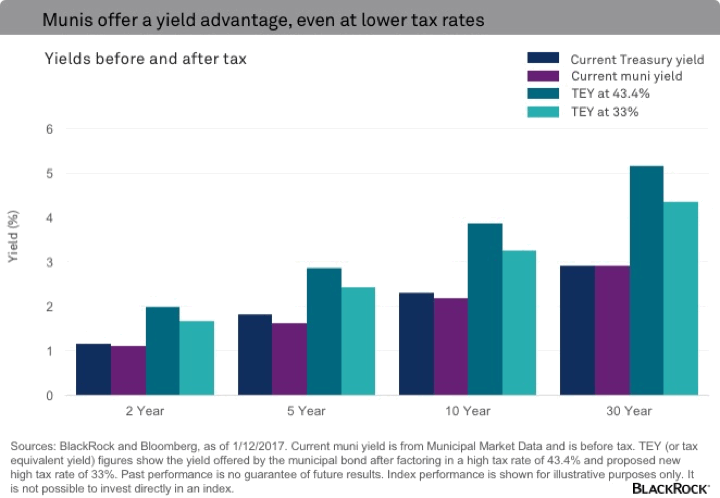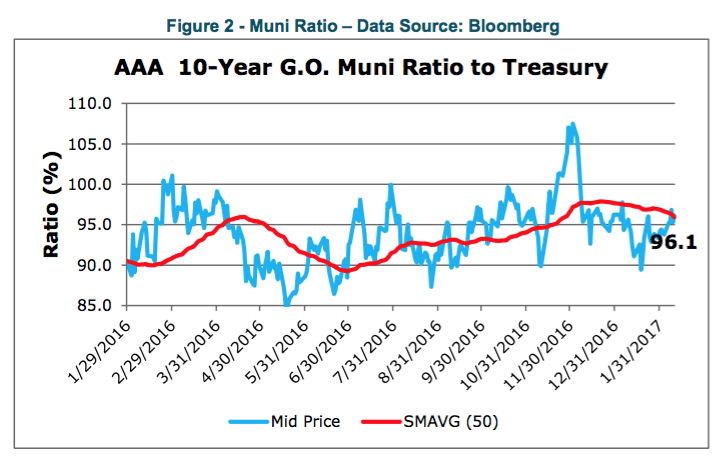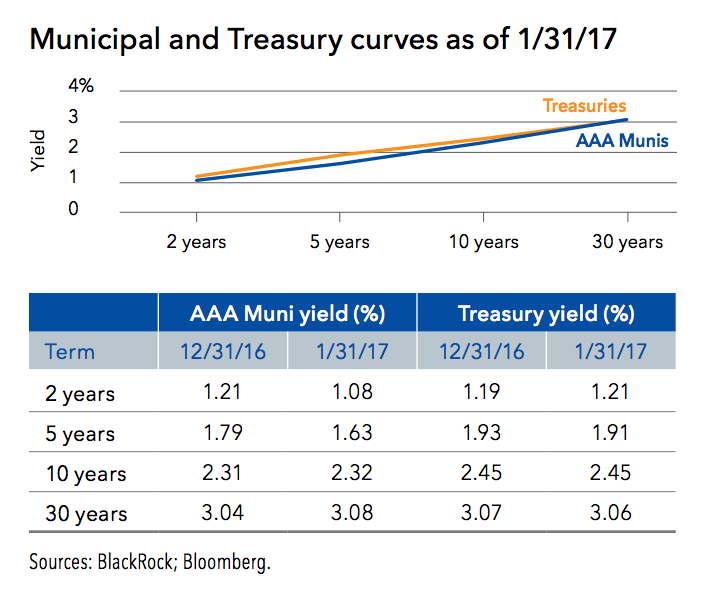As a follow-up to my post on the risks of investing in bonds, I should share that a slight majority of my personal bond holdings are in short-term and intermediate-term municipal bonds. Why? Well, here are some considerations if you are choosing between holding highly-rated municipal bonds and US Treasury bonds right now.
The Blackrock Blog has an article discussing potential effects of tax reform on muni bonds and also their latest Municipal Market Update [pdf]. Here is my interpretation of their points:
Lower individual tax rates would reduce the value of tax-exempt mutual fund income. However, the tax equivalent yield (TEY) of municipal bonds would likely remain higher than that of Treasuries. The calculation is straightforward. For example, at a 28% marginal tax rate, if a municipal bond earned 2%, that would be a tax-equivialent yield of 2/(1-0.28) = 2.78%. Here’s the chart from Blackrock:

It is highly unlikely that the tax-exempt status of municipal bonds will be removed. State and local government need low-cost muni bonds to finance improvements in infrastructure. It is possible that the tax-exemption could be capped, but even in that case the market impact would be manageable.
Here’s the ratio of AAA-rated GO Muni bonds to Treasuries over the last 12 months (Source). As you can see, the ratio hovers around 90% to 95% without compensating for taxes.

Here is a chart of the muni and Treasury bond curves as of 1/31/17:

Their overall conclusion:
We also expect any market correction required to overcome a drop in the highest tax rate or cap on the tax-exemption would be manageable, and continue to believe munis hold an important place in a diversified portfolio.
Purely my opinion… I don’t bother speculating on future tax reform. I’m not an economist, so I can admit that I don’t know the future. I do know that even in the 25% or 28% marginal tax brackets, right now the tax-equivalent yields of muni bonds are higher than Treasuries by a significant gap. At higher marginal tax brackets, the gap widens further (again, see top chart above).
Municipal bonds are not considered as safe as US Treasuries, and smart people can argue as to how close the risk levels are. I personally think the yield gap is greater than the risk gap, enough that I’d rather be in munis, but others may disagree. Why would this happen in a mostly “efficient” market? My personal view is that the entire world (including entire countries and sovereign funds) relies on US Treasuries as their “safe and liquid” asset, pushing yields downward, while the benefits of muni bonds are only available mostly to US individual taxpayers.
Sometimes I think I should just buy a “total bond” fund (tracks all taxable, nominal US investment grade bonds) and forget about it. But then I look at the yield difference. As of today 2/21/17, Vanguard Total Bond Index has an average duration of 6.1 years and 2.50% yield. Vanguard Intermediate Tax-Exempt has an average duration of 5.2 years and 2.07% yield (tax-exempt). At 28% federal tax rate, that is equivalent to 2.88% taxable. At 43.4%, that is equivalent to 3.65% taxable. (These numbers are for Investor Shares; the gap is even bigger if you have $50,000 and can buy Admiral Shares.) Add in the fact that I have limited space in tax-deferred IRAs and 401(k) accounts, and all this is why I pick munis for my taxable accounts.
 The Best Credit Card Bonus Offers – 2025
The Best Credit Card Bonus Offers – 2025 Big List of Free Stocks from Brokerage Apps
Big List of Free Stocks from Brokerage Apps Best Interest Rates on Cash - 2025
Best Interest Rates on Cash - 2025 Free Credit Scores x 3 + Free Credit Monitoring
Free Credit Scores x 3 + Free Credit Monitoring Best No Fee 0% APR Balance Transfer Offers
Best No Fee 0% APR Balance Transfer Offers Little-Known Cellular Data Plans That Can Save Big Money
Little-Known Cellular Data Plans That Can Save Big Money How To Haggle Your Cable or Direct TV Bill
How To Haggle Your Cable or Direct TV Bill Big List of Free Consumer Data Reports (Credit, Rent, Work)
Big List of Free Consumer Data Reports (Credit, Rent, Work)
Informative comparisons. It reassures me that I should keep my position in Vanguard Limited Term Tax Exempt — it has served me well over time.
Just to be a bit contrary though, I’ve always thought this calculation of “tax equivalent yield” to be a bit misleading, although I do understand the point of it. I just think it’s designed — mainly for marketing purposes on the part of fund companies and bond dealers — to imply that you are earning more in a tax exempt investment than you are. You’re not; you’re getting the exact stated yield. What should obviously be the concern to any investor is after-tax return, and it’s puzzling to me that these comparisons do not take that approach. That is the yield on taxable bonds or bond funds should be adjusted to show the impact of taxes in any given tax bracket. I guess that’s not as “sellable” though.
Perhaps it’s just that most bonds are taxable and so the default is before-tax yield. Tax-exempt bonds are a minority and thus they make you do the calculations on the less common situation.
Jonathan,
I know you have paid off your mortgage. But if the choice is between paying off a mortgage(3.375%) and buying CMF (living in California) which one would you pick?
I know logically the mortgage makes sense due to higher rate but on the other hand having the extra cash in CMF means I could liquidate that to buy stocks/real estate at fire sale prices during downturn.
Thoughts?
A possible option would be to think about when your target retirement date would be and set up a payment plan such that your mortgage will be paid off at that time. Say you want to retire in 10 years but mortgage has 15 years left. How much extra would you need to put in each month to accelerate your mortgage payoff to that date? Then put the rest in CMF for liquidity and volatility cushion. See how that split works out to be and see if you’re comfortable with that.